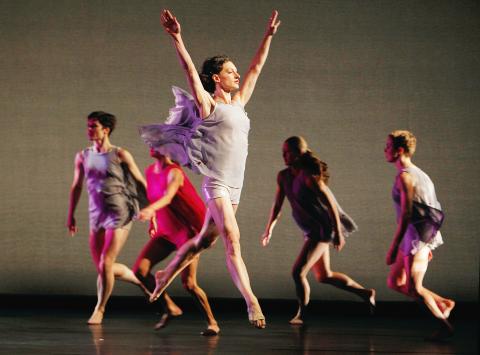Art and politics are converging in Taipei this weekend, both directly and indirectly. The Tsai Jui-yueh Dance Research Institute (蔡瑞月舞蹈社) opens the politics-centered 9th annual Tsai Jui-Yueh Dance Festival tonight at the rebuilt Japanese-style studio off Zhongshan N Road. The venue was Taiwanese dance legend Tsai Jui-yueh’s (蔡瑞月) base for decades. Meanwhile the American Institute in Taiwan (AIT) is hosting a visit by the Mark Morris Dance Group as part of the US Department of State’s DanceMotion USA program.
It may seem a little strange that the 34-year-old Morris troupe is back in Taipei so soon after making its Taiwan debut in June at the National Theater, but the company’s seven-day visit is part of an Asian journey that began in Phnom Pehn, Cambodia on Oct. 13, making a stop at Timore-Leste last week and will wrap up in Beijing on Nov. 16.
Morris’ dancers will be making two public appearances during their stay — tomorrow in Taipei and on Wednesday in Yilan — for what are billed as “Let’s Move” events. The public is invited to dance, exercise and move to music in Liberty Square under the guidance of the dancers. The first 500 participants tomorrow will get a free DanceMotion USA bracelet (the first 200 in Yilan).

Photo Courtesy of Brian Snyder
Since DanceMotion USA is primarily a cross-cultural exchange program that takes well-known US groups and gives them a chance to interact with their counterparts and foreign communities and others through workshops, masterclasses and collaborative events, the company will spend the next few days visiting the National Taiwan University of Arts, the Yilan National Center for Traditional Arts, the Lanyang Museum and the New Taipei Municipal Elementary and Junior-High School in Wulai for workshops with young dancers and Aboriginal students.
One of the partner groups involved in the tour is the National Taiwan University Hospital Parkinson’s Center, which is apropos since the Morris company’s Dance for PD program, offered in eight countries, provides teacher training and free classes for people with Parkinson’s disease.
More information about the Let’s Move events and the troupe’s tour can be found on AIT’s Facebook page (facebook.com/AIT.Social.Media).
Meanwhile, the Tsai Jui-yueh Dance Research Institute will be providing lessons of its own this weekend — lessons in Taiwan’s democratic history since 1994, when the Save the Rose Historic Site movement was launched to rescue the crumbling wooden dance studio.
The Tainan-born Tsai, who died in 2005 at the age of 84, trained in Taiwan and Japan. Her marriage to poet and National Taiwan University literature professor Lei Shih-yu (雷石榆) in 1947, brought her into the murky world of post-Chinese Civil War politics in Taiwan and she spent three years on Green Island as a political prisoner. After her release, she was barred from traveling abroad for decades before moving to Australia in 1983, where her son was working as a dancer.
This year’s Tsai Jui-yueh Dance Festival is subtitled “Democracy in Taiwan” and will combine dance and vocal performances with short talks and discussion groups under the themes of Save Your Culture Yourself (自己的文化自己救) and Save Your Nation Yourself (自己的國家自己救).
The dance portion of the program will reflect the four nations that were central to Tsai’s personal and creative life: Taiwan, Japan, the US and Australia.
Dance Notes
What: Tsai Jui-yueh Dance Festival IX
When: Tonight at 7:45pm, tomorrow and Sunday at 3pm and 7:45pm
Where: Tsai Jui-yueh Dance Research Institute/Rose Historic Site (蔡瑞月舞蹈社), 4F, 40-1, Zongshan N Rd Sec 2 (台北市中山北路二段40-1號4樓)
Admission: NT$600; available at NTCH box offices, online at www.artsticket.com.tw and at convenience store ticketing kiosks
What: Let’s Move Taipei
When: Tomorrow 10am to 11am
Where: Chiang Kai-shek Memorial Hall Square (中正紀念堂自由廣場), 21-1 Zhongshan S Rd, Taipei City (台北市中山南路21-1號)
Admission: Free
Additional Performance: Let’s Move Yilan. Wednesday 10am-11am at the Outdoor Stage of the Luodong Cultural House (羅東文化工場戶外舞台)

April 14 to April 20 In March 1947, Sising Katadrepan urged the government to drop the “high mountain people” (高山族) designation for Indigenous Taiwanese and refer to them as “Taiwan people” (台灣族). He considered the term derogatory, arguing that it made them sound like animals. The Taiwan Provincial Government agreed to stop using the term, stating that Indigenous Taiwanese suffered all sorts of discrimination and oppression under the Japanese and were forced to live in the mountains as outsiders to society. Now, under the new regime, they would be seen as equals, thus they should be henceforth

Last week, the the National Immigration Agency (NIA) told the legislature that more than 10,000 naturalized Taiwanese citizens from the People’s Republic of China (PRC) risked having their citizenship revoked if they failed to provide proof that they had renounced their Chinese household registration within the next three months. Renunciation is required under the Act Governing Relations Between the People of the Taiwan Area and the Mainland Area (臺灣地區與大陸地區人民關係條例), as amended in 2004, though it was only a legal requirement after 2000. Prior to that, it had been only an administrative requirement since the Nationality Act (國籍法) was established in

Three big changes have transformed the landscape of Taiwan’s local patronage factions: Increasing Democratic Progressive Party (DPP) involvement, rising new factions and the Chinese Nationalist Party’s (KMT) significantly weakened control. GREEN FACTIONS It is said that “south of the Zhuoshui River (濁水溪), there is no blue-green divide,” meaning that from Yunlin County south there is no difference between KMT and DPP politicians. This is not always true, but there is more than a grain of truth to it. Traditionally, DPP factions are viewed as national entities, with their primary function to secure plum positions in the party and government. This is not unusual

US President Donald Trump’s bid to take back control of the Panama Canal has put his counterpart Jose Raul Mulino in a difficult position and revived fears in the Central American country that US military bases will return. After Trump vowed to reclaim the interoceanic waterway from Chinese influence, US Defense Secretary Pete Hegseth signed an agreement with the Mulino administration last week for the US to deploy troops in areas adjacent to the canal. For more than two decades, after handing over control of the strategically vital waterway to Panama in 1999 and dismantling the bases that protected it, Washington has